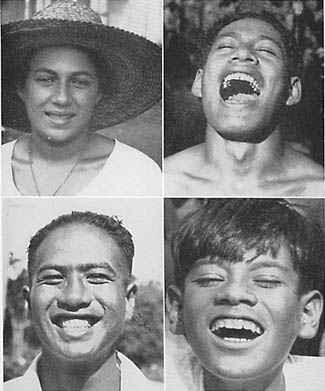
Isolated and modernized Polynesians
THE characteristics of the Polynesian race included straight hair, oval features, happy, buoyant dispositions and splendid physiques. When the Pacific Islands were discovered the Polynesians were found inhabiting the Hawaiian Islands, the Marquesas Islands, the Tuamotu group including Tahiti, the Cook Islands, the Tongan Islands and the Samoan group.
The first group studied was made up of the people of the Marquesas Islands which are situated 9 degrees south latitude and 140 degrees west longitude, about 4,000 miles due west of Peru. Few, if any, of the primitive racial stocks of the South Sea Islands were so enthusiastically extolled for their beauty and excellence of physical development by the early navigators. Much tooth decay prevails today. They reported the Marquesans as vivacious, happy people numbering over a hundred thousand on the seven principal islands of this group. Probably in few places in the world can so distressing a picture be seen today as is found there. A French government official told me that the native population had decreased to about two thousand, chiefly as a result of the ravages of tuberculosis. Serious epidemics of small-pox and measles have at times taken a heavy toll. In a group of approximately one hundred adults and children I counted ten who were emaciated and coughing with typical signs of tuberculosis. Many were waiting for treatment at a dispensary eight hours before the hour it opened. In the past some of the natives have had splendid physiques, fine countenances, and some of the women have had beautiful features. They are now a sick and dying primitive group. A trader ship was in port exchanging white flour and sugar for their copra. They have largely ceased to depend on the sea for food. Tooth decay was rampant. At the time of the examination, 36.9 per cent of the teeth of the people using trade food in conjunction with the land plants and fruits had been attacked by tooth decay. The individuals living entirely on native foods were few. Some early navigators were so highly impressed with the beauty and health of these people that they reported the Marquesas Islands as the Garden of Eden. Tahiti is the principal island of the Society group. It is situated 17 degrees south of the equator, 149 degrees west longitude. Fortunately degeneration has not been so rapid nor so severe here. The Tahitian population, however, has reduced from over two hundred thousand as early estimated, to a present native population estimated at about ten thousand. These islands are also a part of French Oceania. Many of the able bodied men were taken from these French Islands to France to fight in the World War. Only a small percentage, however, returned, and they were mostly crippled and maimed. The Tahitians are a buoyant, light-hearted race, fully conscious, however, of their rapid decline in numbers and health. Many of the more primitive are very fine looking and have excellent dental arches, as seen in Fig. 33.

The capital of Tahiti, Papeete, is the administrative center for the French Pacific possessions. It has a large foreign population, and there is considerable commerce in and out of this port. Much imported food is used. Like on the Marquesas Islands, it was difficult to find large numbers of individuals living entirely on the native foods. Those that were found had complete immunity to dental caries. For the natives living in part on trade foods, chiefly white flour, sugar and canned goods, 31.9 per cent of the teeth were found to be attacked by tooth decay. Typical extensive destruction of the teeth amongst the modernized Tahitians is shown in Fig. 34. There is a large colony of Chinese in Tahiti, brought there as indentured laborers. They have not returned. When the Tahitian men did not return from the war, their wives married the Chinese, who are good workers.
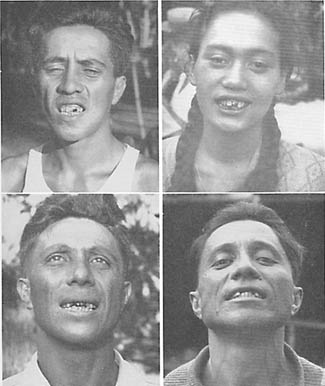
The Cook Islands are British and under the direct guidance of the New Zealand Government. Rarotonga is the principal island. It is situated in the Pacific Ocean in the vicinity of 21 degrees south latitude and 160 degrees west longitude. It has a delightful climate the year around. Racially according to legend, the Maori tribe, the native tribe of New Zealand, migrated there from the Cook Islands. In addition to being similar in physical development and appearance, their languages are sufficiently similar so that each can understand the other, even though their separation occurred probably over a thousand years ago.
It is a matter of great importance that the inhabitants of these South Sea Islands were skillful navigators and boat builders. It was a common occurrence for expeditions both peaceful and aggressive to make journeys of one and two thousand miles in crafts propelled by man power and wind and carrying in addition an adequate supply of water and food for their journey.
A large number were found in Rarotonga living almost entirely on native foods, and only 0.3 per cent of the teeth of these individuals have been attacked by dental caries. In the vicinity of Avarua, the principal port, however, the natives were living largely on trade foods, and among these 29.5 per cent of the teeth were found to have been attacked by dental caries. In Fig. 35 (top) are seen typically fine faces and teeth. However at the lower left is shown a child at the port whose parents were living on the imported food. This boy's upper lateral teeth are erupting inside the arch. In the lower right is a child with normal spacing of the deciduous teeth.
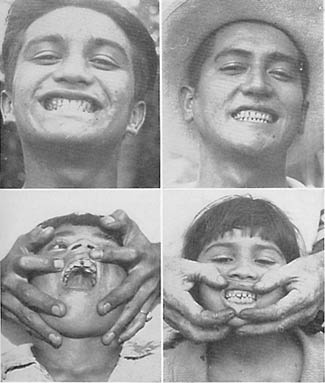
Under British guidance the Cook Islanders have much better health than the Marquesans or the Tahitians. Their population is not seriously decreasing, and is untroubled except for the progressive development of the degenerative diseases around the port. They are thrifty and happy, and are rapidly developing a local culture including a school system supported by natives.
The inhabitants of the Tongan Islands, the principal of which is Tongatabu, are Polynesian. This group, containing over 100 islands, is situated between 18 and 22 degrees south latitude and between 173 and 176 degrees west longitude, and has a native population of about 28,000. They have the distinction of being one of the last absolute monarchies of the world. While they are under the protection of Great Britain, they largely manage their own affairs. Their isolation is nearly complete except for a call from an infrequent trader. They seem to be credited by the inhabitants of the other islands as being the greatest warriors of the Pacific. The Tongans at least acknowledge that they are the greatest warriors, and indeed the greatest people of the world. They will not step aside to allow anyone to pass since they say that when the world was created and populated they were the first to be made, next was the pig, and last the white man. Ethnologically, they are said to be a mixture of the darker Melanesians with their kinky hair, and the fairer Polynesians of the eastern archipelagos with straight hair. It is said they have never been defeated in battle. For centuries they and the Fijian tribes 700 miles to the west have frequently been at war. The British government has very skillfully directed this racial rivalry into athletics. While we were in the Fiji Islands the British government provided a battle cruiser to carry the football team from Fiji to Nukualofa for the annual contest of strength.
These islanders have practiced eugenics by selecting tall strong mates. The queen of the islands was six feet three inches in height.
The limited importation of foods to the Tongan Islands due to the infrequent call of merchant or trading ships has required the people to remain largely on their native foods. Following the war, however, the price of copra went up from $40.00 per ton to $400.00, which brought trading ships with white flour and sugar to exchange for the copra. The effect of this is shown very clearly in the condition of the teeth. The incidence of dental caries among the isolated groups living on native foods was 0.6 per cent, while for those around the port living in part on trade foods, it is 33.4 per cent. The effect of the imported food was clearly to be seen on the teeth of the people who were in the growth stage at that time. Now the trader ships no longer call and this forced isolation is very clearly a blessing in disguise. Dental caries has largely ceased to be active since imported foods became scarce, for the price of copra fell to $4.00 a ton. The temporary rise in tooth decay was apparently directly associated with the calling of trader ships.
The Samoan Islands are located in the vicinity of 14 degrees south latitude and between 166 and 174 degrees west longitude. The native population of the Samoan Islands is Polynesian. The control of the Islands is divided between two governments. The eastern group is American. The western group is British since the World War, before which it was under German control. The western group is now under a mandate to New Zealand. Through the kindness of the Governor and Naval Officers of American Samoa transportation was provided on an auxiliary craft to the various islands of the American Samoan group. We were particularly indebted to Commander Stephenson, Director of Health, whose guests we were, for continued personal assistance in making favorable contacts in nearly all villages of the American Samoan group. In no islands of the Pacific did we find so excellent an organization for health service. Dispensaries have been established within reach of nearly all the villages besides hospital service at Pago Pago, the port of Tutuila. This is the finest port in the Pacific Ocean. Notwithstanding the regular monthly contact through merchant ships to and from America and Australia, many isolated groups were found living largely on the native foods. A dental survey had recently been made of this group by Lieutenant Commander Ferguson. (1)
The excellent facial and dental arch development of the Samoans is illustrated in the upper half of Fig. 36. The change in facial and dental arch form which follows the use of modern food by the parents is shown in the lower half of Fig. 36. Note the marked irregularity of the teeth. This is one of the few groups of islands in which the population is not rapidly decreasing, indeed there is some increase. The Navy personnel includes one dentist. Practically all his time is required for the personnel and families of the Navy at this station. Accordingly, he can do only a limited amount of emergency service such as extractions for the natives. About 90 per cent of the inhabitants of American Samoa are on the largest island, Tutuila, and due to the development of roads, a considerable number of the people have access to the main port, to which several of them come on ship days to sell their wares and to buy provisions to augment their native foods. The incidence of dental caries among those individuals living in part on imported foods at the port as compared with those in remote districts living on native foods was as follows: Those almost exclusively on native foods had 0.3 per cent of the teeth attacked by dental caries, and for those on trade foods, 18.7 per cent. Sea foods used here include many shell fish which are gathered and sold largely by the young people. The octopus, the sea crab and the beche-de-mere eaten raw were used.
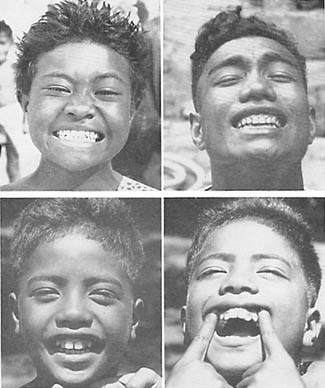
The Hawaiian Islands lie between 18 and 22 degrees north latitude and between 154 and 160 degrees west longitude. These Islands are quite unlike any of the other Pacific Island groups previously discussed. Sugar and pineapple plantations cover vast areas and together constitute by far the most important industries of these Islands. In many districts the population is almost entirely foreign or of various blends, chiefly of Filipinos and Japanese with Hawaiians. There is a large American population and a considerable European. These different racial groups have largely brought their own customs which are rapidly submerging the native customs. Since the native population is so greatly reduced in comparison with the foreign population, and because intermarrying has been so general, it was difficult to find large groups of relatively pure-blooded Hawaiians either living almost entirely on native foods or on modernized foods. Though the number of the individuals in these groups is accordingly not large, important data were obtained for comparing the relative incidence of dental caries and other degenerative processes. While the preparation of foods on the various Pacific Islands has many common factors, all natives using the underground oven of hot stones for cooking, the Hawaiian Islands present one unique difference in the method of preparation of their taro. They cook the root as do all the other tribes, but having done so they dry the taro, powder it and mix it with water and allow it to ferment for several hours, usually twenty-four or more. This preparation called "poi" becomes slightly tart by the process of fermentation and has the consistency of heavy strap molasses or a very heavy cream. It is eaten by rolling it up on one or two fingers and sucking it from them. It accordingly offers no resistance to the process of mastication. In the districts where the natives are living on native foods the incidence of dental caries was only 2 per cent of the teeth, whereas among those natives who are living in large part on the imported foods, chiefly white flour and sweetened goods, 37.3 per cent of the teeth had been attacked by tooth decay. Typical Hawaiian faces are seen in Fig. 37. Typical modern tooth decay is shown in Fig. 38. This girl has tuberculosis also.
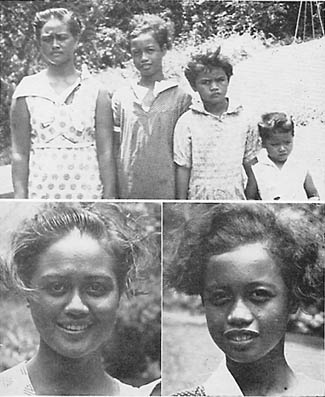
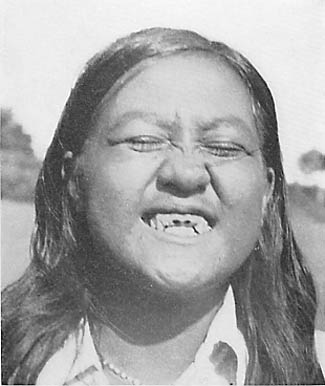
The study of the incidence of dental caries in these various South Sea Island groups in its relation to diet was only one of several of the problems investigated. Since nutrition is the principal factor that has been found related to the r6le of immunity and susceptibility to dental caries in my previous field studies, the collection of foods for chemical analysis and the gathering of detailed data regarding the articles of diet have been very important phases of the activities of this group of studies.
Data were collected for relating the incidence of irregularities of the teeth and dental arches to the types of nutrition. Similarly, studies were made of the individuals who had been hospitalized, in the few places where hospitals existed, chiefly to obtain data regarding the classification of the individuals who were suffering from tuberculosis. These were similar to the studies that I have made among the Eskimos and Indians of Alaska and northern and central Canada.
If one will picture a community of several thousand people with an average of 30 per cent of all the teeth attacked by dental caries and not a single dentist or dental instrument available for assistance of the entire group, a slight realization is had of the mass suffering that has to be endured. Commerce and trade for profit blaze the way in breaking down isolation's barriers, far in advance of the development of health agencies and emergency relief unwittingly made necessary by the trade contact.
While dental caries was most active in the periods of systematic overloads, such as growth, gestation and lactation, even the splendidly formed teeth of the adult men were wrecked by dental caries when the native foods were displaced with modern foods. In all of the groups living on native foods with a liberal intake of animal life of the sea, the health of the gums was generally excellent. When, however, the sea foods were quite limited in the dietary, heavy deposits formed and often were associated with a marked destruction of the supporting tissues with gingival infection. This condition was particularly prevalent among all groups near the ports, when the groups were displacing part of their native foods with imported foods.
In American Samoa through the cooperation of the educational authorities and the Director of the Department of Health, Commander Stephenson, and under the direct supervision of Lieutenant Commander Lowry, the dental surgeon, a group of four young men of the native teaching staff was selected and given instructions for the removal of the deposits. Equipment in the form of instruments has since been provided, in part through the kindness and generosity of some dental manufacturers. This probably constitutes the only native dental service that has ever been available in any of the Pacific Island groups. The intelligence and aptness with which these men were able to learn the fundamental principles, and their skill in carrying out a highly commendable prophylactic operation was indeed remarkable. I gave them pieces of soap and asked them to carve a reproduction of an extracted tooth which was given as a model and in which they were required to increase all diameters to a given amount. Their work would probably equal if not exceed in excellence that of the first effort of 90 per cent of American dental students. Many of these natives are very dexterous with their fingers and are skilled artists in carving wood and other material.
A great service could be rendered to these people who are in the process of modernization, but who have no opportunity for dental assistance, by teaching some of the bright young men certain of the procedures for rendering first aid. They could be compensated by contributions of native foods and native wares much as our itinerant dentists were in earlier days. The people would not have money to pay an American or European dentist for his service until trade is carried on with currency.
Nearly all these racial stocks are magnificent singers for which Nature has well-equipped them physically. Their artistry can be judged by the fact that they sing very difficult music unaccompanied and undirected. A large native chorus at Nukualofa, in the Tongan Group, sang without accompaniment "The Hallelujah Chorus" from Handel's Messiah with all the parts and with phenominal volume and modulation. Much of their work, such as rowing their largest boats, and many of their sports are carried out to the rhythm of hilarious music.
Many of the island groups recognize that their races are doomed since they are melting away with degenerative diseases, chiefly tuberculosis. Their one overwhelming desire is that their race shall not die out. They know that something serious has happened since they have been touched by civilization. Surely our civilization is on trial both at home and abroad.
The nutrition of the primitive Polynesians is continually reinforced with animal life from the sea which includes both soft- and hard-shell forms. The incidence of tooth decay varied from 0.6 per cent for the most isolated groups to 33.4 per cent for the modernized groups. Those individuals living in their native environment on their native foods have universally normal facial and dental arch form reproducing the characteristics of the race. Those living on the normal environment except for using the imported foods of white flour, sugar, sugar products, syrup, polished rice, and the like, have in the succeeding generations marked changes in facial and dental arch forms.
Reference
Next
Table of Contents
Back to the Small Farms Library